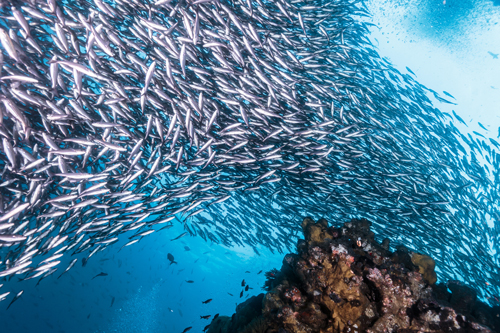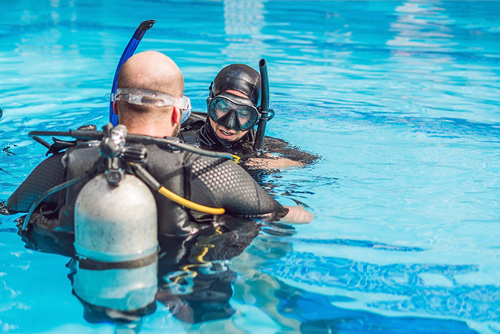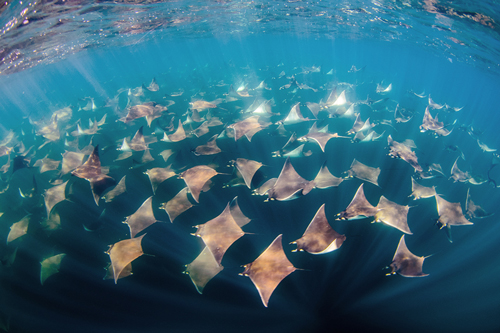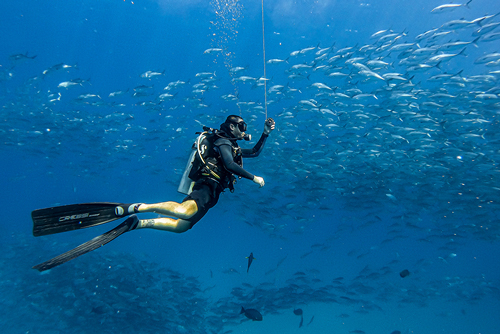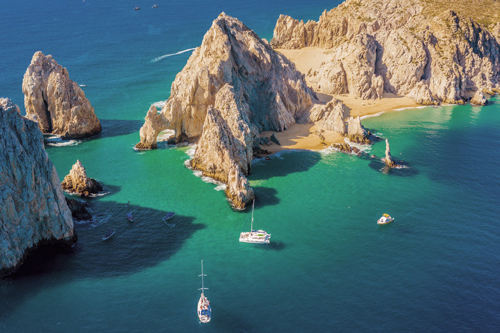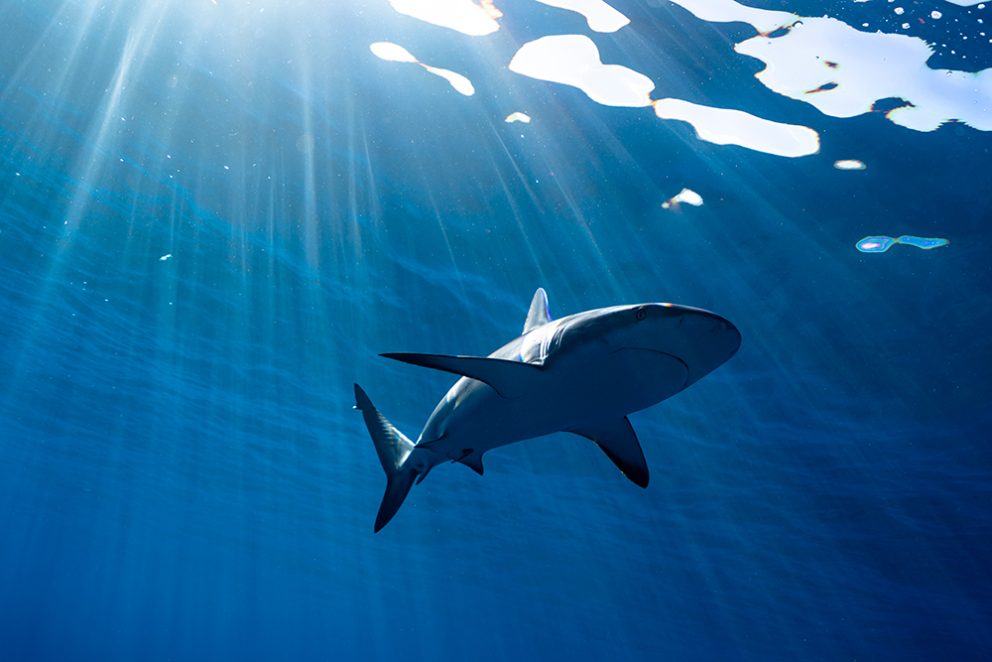Seeing sharks underwater is an exciting opportunity that many divers seek to experience.
The Sea of Cortez and Cabo San Lucas offer incredible biodiversity in marine life and a wide variety of sharks, from Bull sharks to Hammerheads or Whale sharks…
You may wonder where to shark diving and what is the best season to spot shark from Cabo San Lucas?
Here’s the lowdown on some of the commonly spotted shark species in Baja California, so you know what to look out for during your dives!
Video : Shark Diving in Baja Califonria, by Cabo Private Guide
Where shark diving from Cabo San Lucas?
The town of Cabo San Lucas in Baja California, offers incredible dive sites that boast of wildlife encounters ranging from Whale watching to school of Mobula ray and Californian Sea lion.
We know that one of the highlights is the opportunity for a shark diving so here’s a little sneak peek at which ones you may see at our many dive sites in Cabo San Lucas and nearby.
With amazing diversity that includes the Whale Shark, Hammerhead Shark, Bull Shark, Reef Shark and many more… the state of Baja California in Mexico is a world class destination to dive with sharks !
Our dive center organises daily trips to all these dive sites from Cabo San Lucas.

Hammerhead Sharks at Gordo Banks dive site
If it’s the big blue you like and big fish too, come dive into the depths at Gordo Banks.
For the chance to see Hammerhead Sharks, one must be an Advanced Diver.
Gordo Banks Dive site
- Location: Cabo San Lucas
- Dive site: Gordo Banks
- Maximum Depth: 100 feets (30 meters)
- Experience: Advance Open water
- Season: all Year
- Sighting: Hammerhead Sharks, Mobula Rays, Tunas, and big schools of Snappers are other frequent sightings all year round.

Whale Sharks in La Paz National Park
Not everyone in the group is a diver? We have just the trip for you: snorkel with Whale Sharks in the shallow waters of La Paz, Mexico.
If you are a certified diver though, you also have the chance to dive with the Sea Lions of San Rafaelito.
La Paz dive site
- Location: La Paz, Mexico
- Dive site: Bay of La Paz
- Maximum Depth: shallow water
- Experience: No certification required
- Season: From December to April
- Sighting: Whale shark

Bull Sharks in Cabo Pulmo National Park
If you have a day to spare, make sure you don’t miss Cabo Pulmo National Park.
With 8+ dive sites, each less than half an hour by boat, you know the place is teeming with action.
Scuba dive or snorkel along this rich reef filled with fantastic fish life and you could see a Bull Shark.
Cabo Pulmo dive site
- Location: Cabo Pulmo
- Dive site: Vencedor shipwreck
- Maximum Depth: 60 feets (18 meters)
- Experience: Open Water diver
- Season: all year round
- Sighting: Bull Sharks, huge schools of jacks, groupers, turtles and mobula rays

Reef Sharks and Guitar Sharks in Cabo San Lucas
The Bay of Cabos San Lucas and The Corridor of Los Cabos cater to every kind of diver from beginner to expert.
The deep canyon and multiple reefs that take us to our furthest and most exclusive sites have flourishing fish varieties which include White Tip Reef Sharks, Black Tip Reef Sharks, and Guitar Sharks.
Other regulars include solitary turtles, pelagic Billfish, schools of Jackfish, Eagle Rays and even the occasional Humpback Whale next to the boat!
What’s more, every booking gets their own private dive guide. Yes, even if you’re traveling solo !
Cabo San Lucas dive site
- Location: Cabo San Lucas
- Dive site: Land’s End, Neptune finger, The Corridor…
- Depth: 15 feets (5 meters) to 85 feets (25 meters)
- Experience: Beginner diver
- Season: all Year
- Sighting: white tip reef Sharks, Guitarfish, Eagle Rays, Turtles…

Whale Shark: The biggest of all sharks
Whale Sharks (Rhincodon typus) are the largest fish and sharks in the world. Yes, they are indeed sharks and not whales.
Size
Whale Sharks can grow up to a maximum length of about 18 metres in length and weigh anything between 12 to 15 tonnes.
Diet
Whale Sharks are filter feeders that eat either by suction or by opening their wide mouths and swimming forward. They mainly feed on plankton and other small critters like krill, fish eggs, small squids etc and remove excess water from their gills.
Skin Pattern
Like our fingerprints, the pattern on every Whale Shark is unique and can be used to identify individuals. Have a look to Sharkbook.ai to identify Whale shark and help study sharks !
| Common Name: | Whale Shark |
|---|---|
| Scientific Name: | Rhincodon typus |
| Class : | Chondrichthyes |
| Length: | Up to 60 feet (18 m) |
| Weight: | 15 tons |
| Life Span: | Estimated around 70 years |
| Conservation Status: | Endangered (IUCN Red List) |
Where and when to swim with Whale shark in Mexico ?
The best place to swim with Whale Sharks in Mexico it’s in La Paz, from October to April.
La Paz, Baja California State, is located only a couple of hours away from Cabo San Lucas.
Cabo Private Guide organises daily dive trips to snorkel with Whale Sharks and to swim with the Sea Lion Colony.
- Where: La Paz, Mexico
- When: From December to April
Keep reading: Get to know the Whale Shark of La Paz

Bull Shark: The shark with a rounded nose
The Bull shark (Carcharhinus leucas) stands out as a formidable predator, it’s an exhilarating encounter for any scuba diver !
Size
Bull Shark can grow to an average of 3 metres in length and weigh around 250kg.
The female bull shark grows larger in size than the male and gives birth to live young and not eggs like in other shark species.
Shape and color
Bull sharks have rounder, stout noses than other sharks. The bull sharks have lighter colours like grey or white on their underbelly that stand out against the darker colours on their back.
Habitat
Bull sharks are generally found in shallow coastal waters around the world. They can live in both saltwater and freshwater so they have been known to swim into rivers and estuaries.
| Common Name: | Bull Shark |
|---|---|
| Scientific Name: | Carcharhinus leucas |
| Family: | Carcharhinidae |
| Class: | Chondrichthyes |
| Length: | Up to 13 feet (4m) |
| Weight: | 700 lbs (315 kg) |
| Life Span: | Estimated around 25 years |
| Conservation Status | Vulnerable (IUCN Red List) |
Where to dive with Bull Shark shark in Mexico ?
You can scuba dive and encounter Bull Shark in the beautiful Cabo Pulmo National Park, located a only couple hours away from Cabo San Lucas.
Cabo private guide organises daily dive trips to dive with Bull Sharks in the Cabo Pulmo Marine Park.
- Where: Cabo Pulmo National Park
- When: all year round
Keep reading: Cabo Pulmo, Bull shark diving in Mexico

Hammerhead Shark: A fish ID diver’s dream
Hammerhead Sharks are among the easiest to identify from other sharks thanks to their flat hammer like head, also known as cephalofoil.
With eyes placed on either side of their T shaped head, hammerhead sharks enjoy binocular vision and depth perception to detect prey.
Hammerheads also have serrated teeth, the ability to move their head up and down and a centred mouth below that allows them to pin prey like rays to the bottom of the seafloor.
There are around ten different species of Hammerhead shark but the two main species regularly seen in the around Cabo San Lucas are the Scalloped Hammerhead and the Smooth Hammerhead.
Depending on the hammerhead species, they can grow to a size between one to six metres long.
Scalloped Hammerhead
Scalloped Hammerhead Sharks (Sphyrna lewini), also known as Kinky-headed sharks, have two wavy indentations on either side of the central one on their heads.
They get their unique name from the fact that these indentations resemble the shell of a scallop.
| Common Name: | Scalloped Hammerhead |
|---|---|
| Scientific Name: | Sphyrna lewini |
| Family: | Sphyrnidae |
| Class: | Chondrichthyes |
| Length: | 8 feet (2,5m) |
| Weight: | 200lbs (90kg) |
| Life Span: | Estimated around 25 years |
| Conservation Status | Critically Endangered (IUCN Red List) |
Smooth Hammerhead Sharks
Smooth Hammerhead Sharks (Sphyrna zygaena) have no indentations like their scalloped cousins and have a smooth texture.
As far as Hammerheads go, they’re second in size only to the Great Hammerhead Shark.
| Common Name: | Smooth Hammerhead |
|---|---|
| Scientific Name: | Sphyrna zygaena |
| Family: | Carcharhinidae |
| Class: | Chondrichthyes |
| Length: | 10 feet (3 meters) |
| Weight: | 450lbs (200kg) |
| Life Span: | Estimated around 20 years |
| Conservation Status | Vulnerable (IUCN Red List) |
Where to dive with Hammerhead Shark in Mexico?
It’s possible to scuba dive with Hammerhead Sharks at Gordo Banks.
Cabo Private Guide organises daily dive trips to this dive site which is located couple of miles offshore of Cabo San Lucas.
- Where: Gordo Banks, Los Cabos
- When: All year round
Keep reading: Hammerhead Shark at Gordo Banks

Whitetip Reef Shark
The Whitetip Reef Sharks, growing to an average size of a metre and a half, are usually spotted near coral reefs or resting at the bottom.
It has white tips on its dorsal and caudal fins which lend it its name.
Where to dive with White Tips Reef Sharks
White Tips Reef Sharks are frequently spotted while diving in Cabo San Lucas, especially in the Corridor dive sites.
These dive sites are in the Sea of Cortez, only a couple of minutes by boat from Cabo San Lucas Marina.
- Where: Cabo San Lucas, The Corridor (Sea of Cortez)
- When: All year round
| Common Name: | Whitetip Reef Shark |
|---|---|
| Scientific Name: | Triaenodon obesus |
| Family: | Carcharhinidae |
| Class: | Chondrichthyes |
| Length: | 5 feet (1.5 meters) |
| Weight: | 30lbs (15 kg) |
| Life Span: | Estimated around 25 years |
| Conservation Status | Vulnerable (IUCN Red List) |

Blacktip Shark
The Blacktip Shark, similar in size to the Whitetip Reef Sharks, they can be distinguished by the black tips on their fins.
Blacktip Shark are one of the most common species of shark found in shallow waters.
They are one of the select few sharks that can jump out of the water entirely.
| Common Name: | Blacktip Reef Shark |
|---|---|
| Scientific Name: | Carcharhinus limbatus |
| Family: | Carcharhinidae |
| Class: | Chondrichthyes |
| Length: | 5 feet (1.5 meters) |
| Weight: | 40lbs (18 kg) |
| Life Span: | Estimated around 12 years |
| Conservation Status | Vulnerable (IUCN Red List) |

Guitarshark: The one that’s pretending to be a shark
Guitarshark is also known as Guitarfish, they aren’t sharks, they’re rays!
Though they are a part of the group of elasmobranch fishes, they belong to the ray family.
Guitarshark, have flattened heads and wings like rays.
Why Guitarfish get confused with sharks then? Because of the shape of their shark-like tails.
They can often be spotted in Cabo San Lucas Marine Park, especially at a dive site called ‘Neptune’s Finger.’
There are two main species that can be found in Cabo San Lucas: Banded Guitarfish and Shovelnose Guitarfish.
| Common Name: | Banded Guitarfish, Striped guitarfish |
|---|---|
| Scientific Name: | Zapteryx exasperata |
| Family: | Rhinobatidae |
| Class: | Chondrichthyes |
| Length: | 30 inches (80cm) |
| Conservation Status: | Data Deficient (IUCN Red List) |
| Common Name: | Shovelnose guitarfish, Pacific guitarfish |
|---|---|
| Scientific Name: | Pseudobatos productus |
| Family: | Rhinobatidae |
| Class: | Chondrichthyes |
| Length: | 40 inches (100cm) |
| Conservation Status: | Near Threatened (IUCN Red List) |

Pelagic Sharks: Mako, Silky, Blue Shark
Pelagic fish are those that live in the open oceans or far from the coast. Among pelagic sharks, many are migratory such as the Mako, Blue and Silky Sharks.
With the help of satellite tagging in 2021, researchers found that a female Silky shark had travelled 7000km in seven months!
Though it is not common to spot the Mako shark, Blue shark or Silky Shark while diving, these sharks do populate the waters of Baja California and Cabo San Lucas.
They can sometimes be seen during the Blue Water Tours and Ocean Safari organised by Cabo Private Guide.

| Common Name: | Shortfin Mako, Longfin Mako |
|---|---|
| Scientific Name: | Isurus spp |
| Family: | Lamnidae |
| Class: | Chondrichthyes |
| Length: | Shortfin Mako – Up to 10 feet (3 meters) Longfin Mako – Up to 13 feet (4 meters) |
| Weight: | Shortfin Mako – 135 kg Longfin Mako – 200 kg |
| Life Span: | Estimated around 28 years |
| Conservation Status: | Endangered (IUCN Red List) |

| Common Name: | Silky Shark, Gray whaler shark |
|---|---|
| Scientific Name: | Carcharhinus falciformis |
| Family: | Carcharhinidae |
| Class: | Chondrichthyes |
| Length: | 6,5 feet (2.5 meters) |
| Weight: | 170 kg |
| Life Span: | Estimated around 23 years |
| Conservation Status: | Vulnerable (IUCN Red List) |

| Common Name: | Blue shark, Great blue shark |
|---|---|
| Scientific Name: | Prionace glauca |
| Family: | Carcharhinidae |
| Class: | Chondrichthyes |
| Length: | 10 feet (3 meters) |
| Weight: | 150 kg |
| Life Span: | Estimated around 20 years |
| Conservation Status: | Near Threatened (IUCN Red List) |

Great White Shark: The shark that inspired ‘Jaws’
At the top of the marine food chain sits the Great White Shark, the largest predatory fish in the world.
Though they have a terrifying reputation due to depictions in movies and books, the apex predators fall in the vulnerable category in conservation status.
Ironically, this is largely due to man made threats like over-fishing, hunting, and habitat degradation.
Great White Sharks are not found in Cabo San Lucas water; the closest area to observe them is Guadalupe Island.
Guadalupe Island is a Mexican volcanic island in the Pacific Ocean located 252 km west-southwest of the coast of the Baja California peninsula.
| Common Name: | Great White Shark, white shark, white pointer |
|---|---|
| Scientific Name: | Prionace glauca |
| Family: | Lamnidae |
| Class: | Chondrichthyes |
| Length: | Up to 20 feet (6 meters) |
| Weight: | 1,500 to 2,400 kg |
| Life Span: | Estimated around 70 years |
| Conservation Status: | Vulnerable (IUCN Red List) |

Sharks Unveiled: A Tribute to the Ocean’s Apex Predators
What’s a shark?
Sharks belong to the group of elasmobranch fishes like Rays, Skates and Sawfish which have a skeletal system that consists of cartilage rather than bones.
Spanning over 500 sharks species, they can vary from under a metre in length to about 18m which determines their jaw size too.
Sharks display a remarkable diversity in size, shape, and coloration, reflecting their adaptation to a wide range of environments.
Sharks are generally characterized by a streamlined body, cartilaginous skeleton, and prominent dorsal fins, sharks are renowned for their powerful and sleek appearance.
The signature feature of sharks is their multiple rows of sharp teeth, emphasizing their role as apex predators. Sharks can have anything between 3 to 15 rows of teeth that continue to be replaced throughout their lives.
Overall, the physical adaptations of sharks underscore their evolutionary success as formidable and versatile marine predators. They’re among the oldest animals having inhabited all oceans for over 400 million years.
Sharks Habitat
Sharks inhabit a diverse range of ecosystems, from coastal shallows to deep ocean waters.
They are found in both warm and cold seas and can be located near continental shelves, coral reefs, and open ocean environments.
Some species are adapted to brackish or freshwater habitats as the Bull shark, emphasizing their remarkable ability to adapt to various ecological niches.
Sharks Diet
As apex predators, sharks play a crucial role in marine food webs.
Their diet is highly diverse, ranging from small fish and crustaceans to larger marine mammals.
Some species are specialized feeders, such as filter-feeding whale sharks, while others are formidable hunters, relying on their speed and agility to catch prey.
Sharks are known for their keen sense of smell and electroreception, helping them locate food over vast distances in the ocean.
Sharks Behavior & Reproduction
While some species of sharks are solitary, others form schools or aggregations during specific times, such as breeding seasons or when following migratory prey. Did you know that a group of sharks is called a “shiver” ?
Sharks are known for their incredible swimming capabilities, with some species capable of covering vast distances.
Additionally, they exhibit various hunting strategies, from ambush predators to those that engage in more active pursuit of prey.
Shark reproduction varies among species, but most sharks exhibit internal fertilization.
Female sharks typically produce eggs, and males use specialized claspers to transfer sperm into the female’s reproductive tract.
Depending on the species, gestation periods can range from a few months to over a year. Some species give birth to live young, while others lay eggs.
Are sharks dangerous ?
They are not explicitly dangerous to humans and have long captured our imagination in popular culture, books, and movies. It’s not dangerous to dive with sharks when it is done in a respectful and ecological manner.
Video:The Importance Of Shark Conservation by Discovery
Shark Conservation
Why are sharks important?
Sharks play a crucial role in maintaining the health and balance of marine ecosystems.
Being top predators means they help keep the numbers of prey species in check.
By regulating the population of prey species, sharks ensure greater biodiversity.
Healthy shark populations are indicative of a healthy ocean ecosystem.
Why is Shark Conservation crucial?
According to the International Union for Conservation of Nature (IUCN), almost a third of shark species are either vulnerable, endangered or critically endangered.
The biggest threat to sharks is human activity in the form of overfishing, pollution, and loss of habitat.
Sharks help the ocean and us to tackle the problems of climate change.
By preventing overgrazing of seagrass by marine creatures that they prey on, sharks help sustain abundant seagrass meadows. Seagrass is over 30 times more efficient at storing carbon than a rainforest.
Sharks also have significant economic value in ecotourism.
Shark conservation Course
To learn more about shark conservation sign up for our marine conservation course dedicated to the shark species!
PHOTOS CREDIT:
- Photo by Leonardo Gonzalez, Sergey Novikov, RLS Photo, Todd Winner, Uryadnikov Sergey
- Adobe Stock – Standard licenses
SOURCES:
- https://www.iucnredlist.org/
- https://www.worldwildlife.org/
- https://www.nationalgeographic.com/
- https://sharksrays.org/
- https://www.britannica.com/


